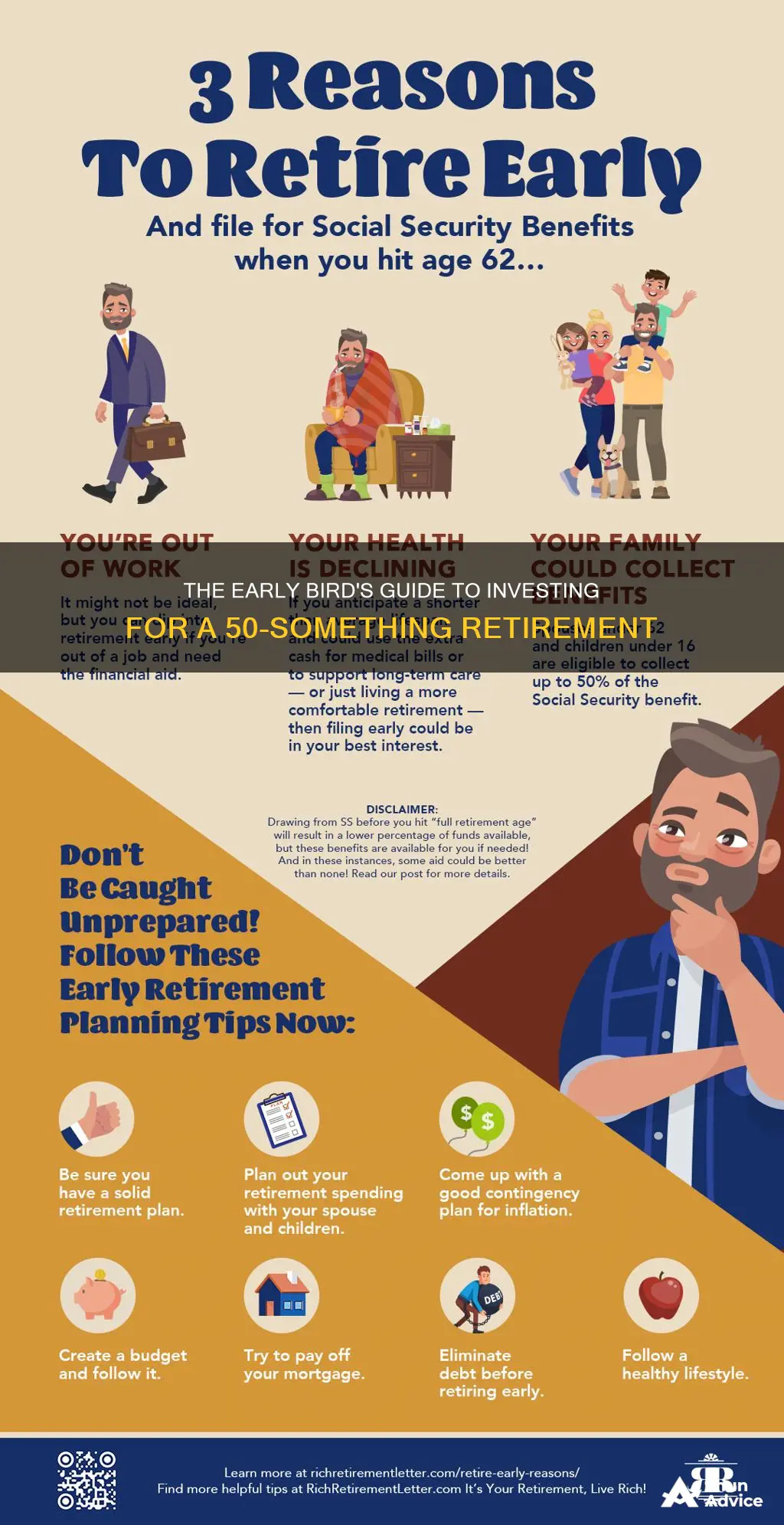
If you're looking to retire at 50, you'll need to start investing early and often. It's important to have a clear idea of what your retirement goals are and what you want your post-work life to look like. Do you want to travel the world or live modestly? Answering these questions will help you determine how much money you'll need to save.
Generally, experts recommend having between five to six times your yearly salary saved by the time you reach 50. To achieve this, you can invest in a 401(k) or IRA, create multiple income streams, and take advantage of catch-up contributions once you're over 50. You may also want to consider working with a financial advisor to create a customized plan and ensure you're making the most of your investments.
In addition to savings, it's crucial to plan for healthcare expenses during retirement and understand the tax implications of your choices. By taking these steps, you can set yourself up for a comfortable retirement and ensure you're making the most of your investments.
| Characteristics | Values |
|---|---|
| Salary at 50 years old | 1.0 (100%) = Annual retirement allowance |
| Salary at 50 years old | 0.6 (60%) = Modest retirement lifestyle |
| Average life expectancy in the U.S. | 76.4 years |
| Average monthly retirement benefit for retired workers | $1,841.27 |
| Maximum benefit in 2024 | $4,873 |
| 401(k) contribution limit for under 50s in 2024 | $23,000 |
| IRA contribution limit for under 50s in 2024 | $7,000 |
| 401(k) contribution limit for over 50s in 2024 | $30,500 |
| IRA contribution limit for over 50s in 2024 | $8,000 |
| Average 65-year-old couple's healthcare costs in the first year of retirement | $11,000 |
| Average 65-year-old couple's savings to cover 90% of insurance premiums and out-of-pocket healthcare costs | $301,100 |
| Median annual cost of a semi-private room in a nursing home in 2021 | $93,600 |
What You'll Learn

Plan your investment portfolio
Planning your investment portfolio is a crucial aspect of achieving your goal to retire at 50. Here are some detailed instructions to help you plan your investment portfolio effectively:
Understand Your Risk Tolerance and Investment Options:
Before investing, assess your risk tolerance and the types of investments available to you. If you have a lower risk tolerance, you may prefer more conservative investments such as bonds, while those seeking higher returns may opt for a more aggressive portfolio with a larger proportion of stocks. Diversification is essential, and a well-diversified portfolio typically includes a mix of stocks, bonds, and cash or cash equivalents.
Determine Your Investment Horizon:
Your investment horizon refers to the number of years you have until retirement. In your 50s, you likely still have a decade or more until retirement, which is an important consideration when choosing investments. Stocks, for example, generally offer higher growth potential over the long term, making them suitable for those with a longer investment horizon.
Assess Your Financial Situation:
Calculate your net worth by subtracting your debts and liabilities (e.g., mortgage, credit card balances) from your assets and savings (e.g., cash, retirement accounts). This will give you a clear picture of your financial status and help you determine how much you can comfortably invest.
Set Clear Retirement Goals:
Define your retirement goals and expenses. Consider your desired retirement age, lifestyle, travel plans, and any other factors that will impact your finances. This will help you estimate the annual income you'll need during retirement and create a budget to work towards.
Maximize Retirement Accounts:
Take advantage of tax-advantaged retirement accounts such as 401(k)s, IRAs, and health savings accounts (HSAs). Contribute as much as possible to these accounts, especially if your employer offers matching contributions. If you're over 50, utilize catch-up contributions to boost your savings even further.
Seek Professional Advice:
Consider meeting with a financial advisor or wealth advisor to create a customized plan that aligns with your goals and risk tolerance. They can provide valuable insights and help you navigate the complexities of investing and retirement planning.
Remember, investing for retirement requires a long-term commitment and discipline. It's important to regularly review and adjust your investment portfolio as you get closer to your retirement age.
Investing: Separating Fact from Fiction
You may want to see also

Max out your retirement accounts
If you're looking to retire early, it's important to start investing early and to make savvy investment decisions. Tax-advantaged retirement accounts like 401(k)s and IRAs are a great way to build up your retirement savings. Here are some tips to help you maximise your retirement accounts:
Understand your retirement goals
Before you start investing, it's important to have a clear idea of what you want your retirement to look like. Do you want to travel the world or have a more modest lifestyle? Knowing this will help you figure out how much you need to save. A good rule of thumb is to expect to need between 60% and 100% of your annual pre-retirement income for each year of retirement.
Take advantage of employer matching
If your employer offers a retirement plan like a 401(k) or 403(b), find out if they will match your contributions up to a certain amount. This is like free money, so try to contribute at least enough to get the full match.
Make the most of catch-up contributions
If you're over 50, you can contribute more to your 401(k) each year. In 2024, the limit for people over 50 is $30,500, which is $7,500 more than for those under 50. If you can afford to, try to max out your contributions to take full advantage of this higher limit.
Consider a Roth IRA
With a traditional 401(k) or IRA, you pay taxes on the money when you withdraw it in retirement. But with a Roth 401(k) or Roth IRA, you pay taxes on the money upfront, and then it can be withdrawn tax-free in retirement. This can be a great option if you expect to be in a higher tax bracket when you retire.
Don't forget health savings accounts
If you're in good health and don't anticipate any major medical expenses, consider putting money into a health savings account (HSA). These accounts are tax-efficient, as contributions are made pre-tax and any earnings grow tax-free. The money can be used for qualified medical expenses at any time, and after age 65, it can be used for non-medical expenses without penalty.
Consult a financial advisor
If you're unsure about how to maximise your retirement savings, consider consulting a financial advisor. They can help you create a comprehensive plan that takes into account your unique circumstances and goals. Look for a fiduciary advisor, who is legally obligated to act in your best interest.
GME: The People's Investment
You may want to see also

Build up your other tax-advantaged accounts
If you're in your 20s or 30s and in good health, consider putting what you can afford to spare into a health savings account (HSA). HSAs are typically a tax-efficient way to save cash for any healthcare needs not covered by insurance. You contribute pre-tax dollars to an HSA, which may be matched by your employer up to a certain percentage. The earnings on those dollars grow tax-free, and anything you spend remains tax-free as long as it's used for qualified medical expenses.
The important thing to know about HSAs is that they don't expire or need to be used by a certain point in time. Unspent money at the end of the year simply rolls over, and you can keep adding more to the account. Your HSA balance is limited to use for qualified medical expenses until you reach age 65. After that, you can use the money for non-medical expenses without paying a penalty, although you will have to pay regular income taxes on the withdrawal.
If your employer offers a high-deductible healthcare plan (HDHP) with an HSA, you may want to consider electing the HDHP and opening an HSA. HSAs have a unique triple tax advantage that can make them a powerful savings vehicle for qualified medical expenses in the current and future years: contributions, earnings, and withdrawals are tax-free for federal tax purposes.
To make the most of your HSA, consider paying for current-year qualified medical expenses out of pocket and letting your HSA contributions remain invested in your HSA. That way, the money has the potential to grow tax-free and be used to pay for future qualified medical expenses, including those in retirement. If you don't reimburse medical expenses in the current year, keep your receipts. You may reimburse yourself for past-year expenses, as long as you incurred your qualified medical expense after you established your HSA.
For more on HSAs, read Viewpoints on Fidelity.com: 5 Ways HSAs Can Fortify Your Retirement.
Carnival Cruise: Invest Now?
You may want to see also

Project your future expenses
Projecting your future expenses is a challenging but crucial aspect of retirement planning. Here are some steps to help you estimate your expenses and plan for a comfortable retirement:
Determine Your Retirement Goals:
Think about when you want to retire and what you want to do during retirement. Do you plan to stop working completely, or will you continue working part-time? Do you want to travel, pursue hobbies, or have a more modest lifestyle? These factors will influence your expenses and help you set a retirement budget.
Estimate Annual Expenses:
Break down your expected expenses into categories such as housing, transportation, healthcare, food, utilities, entertainment, and insurance. Consider using a retirement planner tool to estimate expenses for different phases of retirement. The first stage might involve a transition period where you work part-time, followed by early retirement with more leisure, and then late retirement with potential health-related expenses.
Consider One-Time Costs:
In addition to your regular expenses, there may be one-time costs, such as education for children or grandchildren, purchasing a second home or recreational items, or contributing to care for aging parents. These expenses can significantly impact your overall financial plan.
Plan for Housing Costs:
Housing is typically one of the largest expenses in retirement. Consider whether you want to pay off your mortgage, downsize to a smaller home, or relocate to a different area with a lower cost of living. These decisions will have a substantial impact on your retirement budget.
Estimate Healthcare Costs:
Healthcare costs can be challenging to predict, but they are a significant expense for retirees. Consider your family's medical history and the potential need for long-term care. According to Fidelity's estimates, a retired couple aged 65 in 2023 may need approximately $315,000 to cover healthcare expenses throughout retirement.
Use Available Tools and Resources:
Take advantage of online calculators and tools, such as retirement planners and budget calculators, to help you estimate your future expenses. These tools allow you to input various scenarios and factors to personalize your retirement plan.
Consult a Financial Advisor:
Working with a financial advisor can be beneficial, especially if you're unsure how to estimate expenses or create a comprehensive plan. They can provide expertise and guidance tailored to your specific situation, helping you make informed decisions about your future.
Remember, projecting future expenses is an essential step in retirement planning. It will enable you to save effectively, make informed investment decisions, and ensure you have sufficient funds to cover your expenses during retirement.
LLCs: Why Investors Are Wary
You may want to see also

Take advantage of tax-deferred accounts
Tax-deferred retirement accounts are a great way to save for the future while reducing your taxable income today. Here are some reasons why you should take advantage of tax-deferred accounts to retire at 50:
Lower your tax bill right now
Tax-deferred accounts like traditional IRAs and 401(k)s allow you to lower your taxable income in the current year. You can subtract your contributions from your taxable income, which may reduce your tax liability and potentially move you into a lower tax bracket. This is especially beneficial if you're in a high tax bracket as it can result in significant tax savings.
Raise the potential for compounding
Compounding is a basic principle of investing, where any earnings received can produce earnings of their own, creating a cycle of growth over time. Tax-deferred accounts allow you to invest funds before paying taxes on them, giving more of your current funds the opportunity to take advantage of compounding.
Save on taxes over the long term
If you expect your income to drop during retirement, your tax bracket may also decrease. In that case, you could end up paying less in taxes over time since withdrawals from tax-deferred accounts in retirement are taxed at your current tax rate, which may be lower than when you were working.
Eliminate current taxes on investment gains
Within a tax-deferred account, you can buy and sell assets without triggering any taxes. This allows you to make investment moves without worrying about the tax implications, as long as the money stays within the tax-deferred account.
Support your savings discipline
Withdrawing money from a tax-deferred account like a traditional IRA or 401(k) before the age of 59½ typically comes with a 10% early withdrawal penalty. This can help deter you from tapping into your retirement savings early and encourage you to build your nest egg for the long term.
Smart Ways to Invest Your $50
You may want to see also
Frequently asked questions
While there is no hard-and-fast rule, a good benchmark is to have saved between three-and-a-half to six times your yearly salary by the time you reach 50.
You can open a retirement account such as a 401(k) or IRA, take advantage of catch-up contributions, and/or start your own business.
Some common mistakes to avoid include not saving early, not taking healthcare costs into consideration, taking Social Security benefits early, and spending too much in your early retirement years.
It's important to assess your situation and set realistic goals, project your future expenses, and run a tax projection. You should also consider partial Roth conversions, take advantage of tax-deferred accounts and catch-up contributions, and sharpen your retirement budget.







